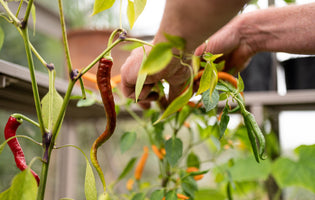House plants not only add a dash of greenery, a splash of color and a whole lot of joy to the home – they’re also a source of good health and happy vibes! House plants have been proven to have air-purifying qualities, increase productivity, promote better sleep, boost your mood and reduce anxiety.
They’re also the perfect option for those folk who might live in big cities, small spaces or apartments without gardens. Once you’ve mastered a few simple steps for caring for your indoor plants – you’ll be hooked on just how rewarding and enriching they can be! And the great news is there are so many to choose from. Your home will soon become a lush, tranquil oasis, and you’ll be super impressed with your newfound, green-fingered prowess.
In this blog, we will explore a few popular houseplant options and the basics of caring for them.
Best low-light house plants
Snake Plant (low light, drought tolerant)
Snake plants are a popular home decor choice. Also known as mother-in-law’s tongue or sansevieria, they’re attractive, super easy to care for and don’t need a lot of water to survive. They’re low maintenance, so there’s very little chance you’ll kill them, even if you don’t have a green thumb.
Snake plants look similar to artificial plants with their characteristically thick, sword-shaped leaves. They’re the perfect aesthetic addition to smaller spaces, too, due to their lack of branches and upright growth. This common houseplant, which is native to both Asia and Africa, also acts as an air purifier. It’s best to keep them away from animals and children as they can be mildly toxic if ingested.
Snake plants are prone to root rot due to overwatering, so it’s recommended you let the soil dry out between waterings.
Snake plants can be fast growers in the right conditions and can be easily propagated which makes them great gifts for family and friends.
Propagation is most effective during springtime. However, newly propagated plants grow more abundantly during summer. To propagate, simply trim two to three inches of leaves containing roots, then place these leaf cuttings about one inch deep in the soil and wait for them to grow.
To ensure healthy growth, you can replace your snake plant’s soil every eight to 12 months. If your snake plant’s new leaves begin to wilt before they can grow, or if the older ones appear to be unhealthy, you’ll need to re-pot your snake plant. Repotting at least once every two to three years can help them flourish and maintain their health. Also, prune your snake plant as needed, clean the leaves regularly and use fertilizer.
Peace Lily (low to medium light, high humidity)
The Peace lily, Spathiphyllum Wallis, is a low-maintenance popular house plant with gorgeous glossy green leaves and white flowers known as spathes. Native to Central America, it's used to a warm, humid environment and is ideal for adding a splash of luscious greenery to a well-lit humid bathroom.
Peace lilies are relatively hassle-free and easy to grow. They don’t need a lot of light and thrive in bright indirect light. They’re not fans of cold drafts, so don’t place them near doors or fireplaces. Water your peace lily regularly, keeping the compost moist but not wet. In spring and summer, you can feed them good quality house plant food every two weeks. Wipe or dust the leaves regularly to ensure they photosynthesize effectively, and mist around the leaves to increase humidity if your room is dry.
Water your peace lily regularly so the soil is never completely dried out but is also not waterlogged – wait until the top few centimeters of compost have dried out before watering again. If you don't water them often enough, you'll soon be alerted as peace lilies wilt when dehydrated. Simply water again and maintain your watering regime.
Pothos (low to medium light, adaptable)
Pothos is a rewarding indoor plant year-round and will grow rapidly, often adding between 12 to 18 inches of length in a month. They’re one of the easiest houseplants to grow, even if you’re notoriously bad with plants! This trailing vine, which hails from the Solomon Islands in the South Pacific, sports heart-shaped pointed green leaves that are sometimes variegated with pale green, yellow or white striations. Be careful, as they can be toxic for pets.
While pothos prefers bright, indirect light, it can also flourish in low-light areas or those areas with only fluorescent lighting, making it an ideal option for offices and dorm rooms. Pothos also do well in high humidity and are well suited to kitchens and bathrooms.
Spider Plant (bright to medium light, adaptable)
Spider Plants, or Chlorophytum, are easy-to-grow house plants and also easy to care for. In fact, they're one of the most rewarding and straightforward indoor plants.
A really nifty aspect of a spider plant is its ability to rapidly propagate itself through its plant parents -a baby plant from the mother plant will readily root and flourish. They’re also incredibly beneficial for your health, as they filter and safely remove chemical vapors and pollutants from your home. Spider plants are exceptionally tolerant, even if you accidentally forget about them now and then. This is due to their ability to store moisture and food in their thick white roots for long-term nourishment.
Best bright-light house plant
Aloe Vera (bright light, low humidity)
With its amazing healing abilities, the sap of Aloe vera (also known as the first aid plant) can be used to soothe sunburn, skin irritations, scalds, insect bites and burns. Aloes grow well in bright spots such as windowsills and shelves - but take care, as too much direct sun will burn the leaves. Only water aloes when the top few centimeters of soil have dried out, allow any excess to drain away completely and don't water at all in winter. Aloes are attractive on their own but also combine well with cacti and other succulents.
Caring for Houseplants:
When tending to houseplants, you try to copy their natural environment in your home, considering nutrition, humidity and, most importantly, soil.
To care for houseplants, follow these guidelines:
Light: Choose a location with the right amount of light for each plant.
Most houseplants will flourish in a well-lit, draft-free spot with a regular temperature and reasonably high humidity. However, some plants have unique requirements.
For instance, those with variegated foliage and flowering plants need more light than plants with plain green foliage, while ferns prefer a darker position. Succulents, cacti and carnivorous plants enjoy a bright windowsill but avoid placing them on a south-facing sill in summer, where they could burn. Orchids prefer indirect bright light and plenty of high humidity and fresh air.
Watering: Water when the soil feels dry, avoiding overwatering.
Soil: Use well-draining soil. A quality potting soil mix is the best way to ensure your house plants thrive. When purchasing potting soil for your houseplants, aim for a well-draining potting mix especially suited for indoor plants. Indoor potting mixes are formulated to provide indoor plants with the moisture, airflow and nutrients their roots need. Avoid anything targeted for outdoor plants, as the makeup of the mix won’t be suitable for house plants.
Temperature and Humidity:
Approximate guide for the lowest temperatures:
- Tender plants: 15°C
- Half-hardy (many indoor plants): 10 – 13°C
- Hardy: 7°C
Aim for humidity levels of between 40-60%.
fertilizer: Fertilize regularly according to the specific needs of each plant.
Pruning: Prune to remove dead leaves and encourage growth. Pinch off dying flowers with your thumb and forefinger and remove any yellowing, shrivelled or damaged leaves. Remove straggly or wayward branches with scissors if necessary.
Pests: Inspect for pests regularly and treat them promptly if necessary. If the plant is looking a bit lacklustre, inspect it for tufts of white fluff. This is either a woolly aphid or mealy bug, pests that suck the sap of houseplants.
Remove them with an organic soft soap spray. Fine webbing at the tips of plants and yellow speckling on leaves is indicative of red spider mites, which can be prolific in a dry, warm atmosphere – remove the affected parts and mist around the plant to thwart another outbreak.
Conclusion: By following these guidelines, you can enjoy the many magical benefits of having houseplants and keep them looking healthy and beautiful in your home.







